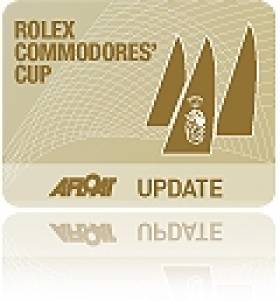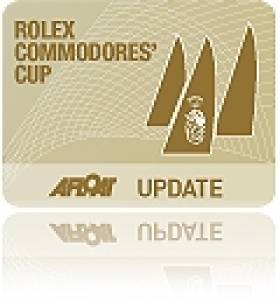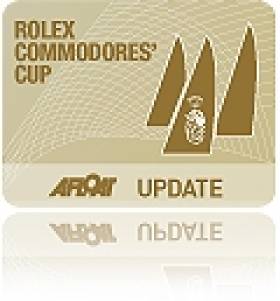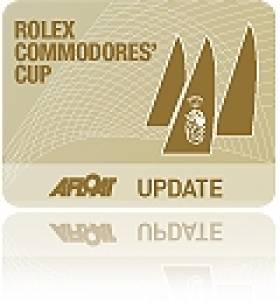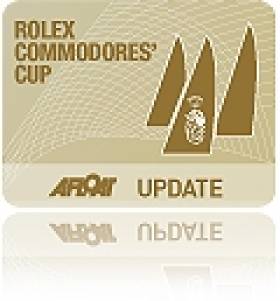Displaying items by tag: Solent
Unstoppable Ireland Win 2010 Commodores' Cup
Ireland has won the 2010 Commodores' Cup but it was not without final race drama this morning. According to reports from the race course, Team Captain Anthony O'Leary was in a collision before the start of the race with a French competitor when winds gusted to 30 knots.
The news that Ireland has won the Cup is already being celebrated in Crosshaven this lunch time, the home of the three boat team.
The winning Ireland team from Royal Cork was Antix, Anthony O'Leary (Ker 39); Marinerscove.ie David Dwyer (Mills 39) and Roxy 6 Robert Davies (Corby 36).
After a series of near misses in the Commodore’s Cup, there are many reasons why 2010 was entirely appropriate timing for the Irish win in Cowes this week.
Ireland fielded a single three boat team instead of its previous two and three team approach. Individual performances this season though, including a win at the British IRC Nationals were early indicators that Ireland still had the will to win the Commodore's Cup.
And it was obvious this week from the first inshore race on Sunday that Ireland would take a lot of stopping.
To send your congratulations to the Irish team click here
To join our forum thread click here
Update: Ireland Going Well In Round the Island Race
Ireland is off to a great start this morning in the Round the Island Race. ICRA Commodore Barry Rose is out by the Needles. He says: "Antix is doing super in Class 1. Mariners is fourth on the water and ahead of most her Class One. Roxy second to Rockall, probably third in class" More as we have it.
keep up to date here:
http://commodorescup.rorc.org/fleet-tracking/2010-live-offshore-tracking.html
Send good luck messages here:
http://www.afloat.ie/commodores-cup/item/13716-commodores-cup-send-your-good-luck-wishes-here/
Ireland Continue to Lead Commodores' Cup
Two race wins and a third place for the Irish Cruiser Racing Association (ICRA) team at Cowes have extended Ireland's lead by ten points overnight as the event reaches its penultimate phase tomorrow with the Round Isle of Wight Race. Strong winds gusting to 25 konts are forecast and the team is focussed on avoiding damage.
Ireland has a 40.5 point lead over second placed Hong Kong and 49 points over third-placed France Blue.
Team Captain Anthony O'Leary on Antix won Class 1, continuing his consistent form of race wins and second places this week. Roxy 6 skippered by Andrew Creighton benefitted from an apparent navigational error by Hong Kong's Rockall III that was leading comfortably in Class 3 until a course change was missed and the Irish team boat won the race. Dave Dwyer's marinerscove.ie placed third in Class 2 in a race dominated by British boats La Reponse and Quokka 8.
"We have a very workman like approach to prepararing thoroughly for the 50-miler tomorrow," commented Barry Rose, Commodore of ICRA. "The course has lots of complicated corners and we expect it to be breezy. Its a big challenge that we're taking day by day; our plan goes on as it has from the beginning, concentrating on every detail to be as prepared as we can."
The race around the island counts for 1.5x bonus factor and will be especially tough in the forecast conditions. "The race around the Isle of Wight is going to be pretty long and pretty tough for the small boats," Maurice O'Connell, mainsheet trimmer on Roxy 6. "We're just going to keep doing what we're doing and hope that it all comes good."
A grim overcast start and lumpy wind against tide conditions gave way to brilliant sunshine and a summery finish off the Royal Yacht Squadron for the Rolex Trophy Day inshore race at the 2010 Rolex Commodores' Cup. Today's one race was held around multiple marks in the central western Solent starting in 18 knot southwesterlies with a wet beat through short chop before the tide turned and the wind dropped gradually through the race, ending at below 10 knots .
It was another solid day for the Irish team, leaders since the opening day of the regatta last Sunday. Their big boat, Anthony O'Leary's Ker 39 Antix and their small boat, Robert Davies' Corby 36 Roxy 6 both won their classes today while David Dwyer's marinerscove.ie posted a third. No other team was close to being as consistent today.
In the small boat class Roxy 6 came out on top partly thanks to a navigation error on the Hong Kong boat, Christopher Opielok's Corby 36 Rockall III [at the time of going to press this was subject to a protest for redress]. "We were very lucky," said Roxy 6's helmsman Andrew Creighton. "Rockall went to a wrong mark and they were ahead of us. With them making that mistake it obviously pushed us into first, although one of the French guys, Goa, came very close to us, but we had them by about 25 seconds."
Roxy 6 was only launched in April, but has had an intensive season at regattas throughout the UK and her native Ireland. Designed by Cowes resident John Corby, the 36 footer relished today's conditions. "The short Solent slap suits this sort of boat," said Creighton.
Back at Cowes Yacht Haven, Commodore of the Royal Ocean Racing Club, Andrew McIrvine stepped off the boat he co-owns with Peter Morton in buoyant mood. His Beneteau First 40.7 La Réponse won the mid-sized class today by two and a half minutes on corrected time ahead of past RORC Commodore Peter Rutter's Quokka 8.
"We just went fast," said McIrvine explaining today's result. "Upwind we go higher and faster than we ought to for this size of boat if you consider it is a cruiser racer. Downwind we go quick too. It is a semi-standard production boat and it does go extremely well." McIrvine acquired the boat this year from past Rolex Commodores' Cup winner Géry Trentesaux and has changed the bulb keel back to a fin but kept the go-faster carbon fibre mast.
"Tactically we didn't make any mistakes. The crew are fantastic. All the gybe sets worked perfectly. There were no foul-ups on any of the manoeuvres. They are a very well tuned team now," added McIrvine.
Second behind Antix, Bernard Gouy's Inis Mor in France Yellow had their best day yet, making it a Ker 39 1-2 in the big boat class today.
"Our spinnaker legs were better today with the asymmetric [spinnaker]," stated Laurent Gouy, the owner's son. "We have some difficulty when it is really downwind and when it is wavy we can compensate to slide downwind a bit better."
Behind them in third, the Hong Kong big boat EFG Bank Mandrake posted their best result of the regatta today. "I thought it was superb," said Nicholas Burns, co-owner with Fred Kinmonth. "I think we sailed as good a race as we could have done. We tacked about 20 times on top of Antix and she still beat us! She is going very fast at the moment, so I think our tactics will change now. We'll just go for the best position we can and not try and knock the Irish back."
As to the regatta generally, Burns said: "Very challenging, superb sailing, all the competition is extremely good and we're really enjoying it. It is colder than we are used to. We are used to Asian temperatures of 29-33 degrees Celsius. We have lots of warm ski gear on, but it has been really good fun."
EFG Bank Mandrake, a Mills 40 design, previously raced at the Rolex Commodores' Cup in 2006 as an Irish entry under the name Tiamat. She was shipped to the UK from Palma especially for this regatta and will head to Hong Kong afterwards. "It is great fun," says Burns of the regatta. "It is nice to have a team race with three boats in different classes. It is a really good idea. You feel you are sailing some of the best sailors in the world which is challenging."
At the end of play today the Hong Kong team lies second to the runaway Irish, but have been knocked back due to their small boat Rockall III's mishap, causing her to finish ninth (depending upon the outcome of their protest). From being 30 points astern of the Irish yesterday, the Hong Kong team is currently 40.5 points behind them. However the regatta is far from over with a race around the Isle of Wight coming with a x1.5 points co-efficient tomorrow (Friday) and a double points scoring inshore race to conclude the regatta on Saturday.
As RORC Commodore Andrew McIrvine puts it, "although the Irish have got away there is still almost half the points to play for. The weighting keeps the whole thing open right to the end of the event. At a lot of regattas by this stage it is signed sealed and delivered. We have still got a long way to go."
Conditions for the race around the Isle of Wight look set to be brisk with southwesterly winds gusting up to 25 knots forecast.
Crews competing at the Rolex Commodores' Cup will return to offshore mode tomorrow. The Irish will look to consolidate their dominance, whilst those chasing, particularly Hong Kong, will look to take advantage of any errors by the all but impeccably sailed leaders.
Top Five Teams - Provisional Positions after completion of 6 races
Team / Points / Place
Ireland / 47 / 1
Hong Kong / 87.5 / 2
France Blue / 96/ 3
GBR Red / 103 / 4
France Yellow /110 / 5
Rolex Trophy Honours Up for Grabs This Morning
Ireland Tackle Offshore Race to Take Commanding Lead
Boats were returning to Cowes Yacht Haven throughout yesterday, back from the offshore race of the 2010 Rolex Commodores' Cup. With a 2.5x point co-efficient this race had the potential to provide a major upset in the results, but after four days of competition the Irish team hold an even more commanding lead, now up to 29.5 points. Hong Kong has regained second place, this time with a 25-point cushion over the leading French team, which in turn is just 5 points ahead of GBR Red and 15 points ahead of France Yellow in fifth.
Dave Dwyer’s marinerscove.ie was overall winner of Class 2 while team captain Anthony O’Leary’s Antix scored second place. Rob Davies Roxy 6 skippered by Andrew Creighton was fourth in Class 3.
“We’re feeling quite positive as we’ve just had one of the best offshore results ever – the lads all worked their socks off,” commented Barry Rose, Commodore of ICRA. “We’ve strengthened our lead so we’re in a good, solid position and looking forward to the rest of the regatta.”
The team had all returned to Cowes by mid-afternoon to prepare the three boats for tomorrow’s (Thursday) Rolex Trophy race on a long-inshore race that is expected to last three hours. Friday will also feature a single race as the fleet competes for bonus points in the Round Isle of Wight course.
Saturday’s single race finale counts for double-points and strong challenges from Hong Kong, France Blue and Britain’s GBR Red are expected.
“Its still all to play for. Hong Kong are looking very strong and there are a lot of points still to be earned,” cautioned Rose. “There’ll be no change in our strategy – we have a plan and we’re going to stick to it. Its about grind out the results day by day.”
Hong Kong and Ireland scored equal points in the offshore race with the former's Rockall III winning the small boat class while the latter's marinerscove.ie claimed the mid-sized class.
On the water Rockall III was first home in the whole fleet, crossing the line just to the west of the entrance to Portsmouth Harbour at 10:40:41 BST, winning her class by almost one hour on corrected time. While racing for Hong Kong, where he used to live, Rockall III's owner Christopher Opielok is German. His crew is largely from Hong Kong but also includes two Dutch, one Irishman and three Australians. According to Opielok he bought his Corby 36 specifically to compete in the Rolex Commodores' Cup, "we have been preparing for this for a long time. The boat clocked since delivery to us last year, 4,000 miles. We did a lot of offshore racing. We have four very good helmsmen. The navigation was very well prepared. We had a good tactician and I believe altogether with a very good boat, ended up with this result."
Opielok said they faced stiff competition from the Irish team's small boat, Roxy 6, "we focussed on sail trim and sailed extremely hard without any rest. We knew we could only beat Roxy upwind. We put all our effort into the 60-mile beat and then we tried to control them downwind. Luckily the tide went with us and pushed us even further than expected." The tide was particularly beneficial on the final run into the finish.
Simon Henning, owner of the Alice II from GBR White was delighted to have won the big boat division. His Farr 45, the biggest yacht in this year's Rolex Commodores' Cup does not have a favourable rating and they have not performed well in the inshore racing so far. Having to continue past Anvil Point and on to the East Shambles mark in Weymouth Bay, the Class 1 course at 191-nautical-miles was some 35 nm longer than the Class 3 version, which simply did an about-turn at Poole. Yet Alice II reached the finish line just under four minutes astern of Rockall III.
Alice led the 30-boat fleet out of the Solent in the strongest conditions of the race and enjoyed a fantastic blast down to the Owers, the easternmost mark of the course, to the southeast of Selsey Bill. "We saw 24-25 knots [of wind] and we were surfing up to 17 several times – it was lovely," commented Henning. Thanks to this they caught the tide turning at the Owers and from there never looked back. Despite the wind dropping to five knots this morning, they claimed the big boat class by a margin of 1 hour 20 minutes on corrected time.
Aside from torrential rain yesterday afternoon, conditions were not as bad as had been forecast. In the southwesterly breeze the sea was being kicked up by the wind-against-tide on the first beat out of The Solent and apart from the overfalls off St Catherine's Point, the southern tip of the Isle of Wight, it was generally considered a pleasant race.
"It was great fun - the course had a fabulous variety," commented Anthony O'Leary, who's Ker 39 Antix corrected out to be second amongst the big boats. "Every corner we went around it seemed that the tide was against us, but that was part of plan to give us a varied course with all the options and all the challenges - and there were plenty. Going into Poole Bar in the middle of the night and the Anvil in the dark is a challenge but thankfully we got away and managed to hold the thing together."
O'Leary was thankful that the Irish team had cumulatively posted a solid result in this high scoring race. "You could easily lose the regatta if you had a disaster and in that respect it is certainly satisfying. But there is still plenty to do and there are still plenty of points available. We'll keep on chipping away."
David Dwyer's marinerscove.ie maintained the impeccable Irish performance, first home in the mid-sized class, although by the slender margin of three and a half minutes over Anthony Day's Blondie IV. Tactician on the Irish boat, Andy Beadsworth, commented that, "it was a really good race and it was nice to finish relatively early today." The team enjoyed spending most of the night racing in company with the big boats. "It wasn't that lumpy. We hardly had any water over the deck!" said Beadsworth, adding that he had tried to get some sleep only to be awoken when he overheard the rest of the crew about to make decisions on deck.
Finishing behind Rockall III in the small boat class was Bernard Moureau's JND 35 Gaia in France White. Tactician Alex Mercier said that they are improving with every race aboard their new boat. "The start was a bit improvised but we were able to place ourselves well and to maintain a good position during the entire night and this morning as well." They are still discovering Gaia but have found it goes well under spinnaker.
Behind them in third was Jim Macgregor's Elan 410 Premier Flair, which posted the best result for GBR Red, with another crew who had thought they would perform better inshore than off. The line-up includes British Olympic-squad 470 sailor Ben Saxton as tactician. "It was long but enjoyable, different. It was nice weather because it was windy enough and we made good progress and we finished close to other boats so that kept it fun the whole way around," said Saxton who admits he only slept for about five minutes. Saxton reckons they made their biggest tactical gains with the tide on the beat up to Poole.
Tomorrow the Rolex Commodores' Cup returns to racing on The Solent with one inshore course scheduled for Rolex Trophy Day. Crews get a well-earned rest following their efforts of the past 24 hours or so, with the start scheduled for noon BST. With two high scoring races to follow on Friday (the x1.5 Round the Isle of Wight Race) and Saturday (a double-points inshore race) the teams at the top know this event is far from over. The Irish will sleep more comfortably tonight having cruised through the major test of the week, but undoubtedly will be on alert tomorrow to avoid the pitfalls encountered by previous compatriot teams.
Top Five Teams - Provisional Positions after completion of 5 races
Team / Points / Place
Ireland / 42 / 1
Hong Kong / 71.5 / 2
France Blue / 84 / 3
GBR Red / 89 / 4
France Yellow /99 / 5
Offshore Race: First Boats Due Home at 11am (Podcast Here!)
Ireland has performed strongly in the decisive offshore race in the Commodores' Cup. The first boats are expected back by 11am. ICRA Commodore Barry Rose gives a 9am dockside podcast update below but it's 'no comment' from Team Ireland on the penalty imposed on GBR Red's Quokka 8.
British Yacht Penalised in Commodores' Cup
A British yacht in the Rolex Commodores' Cup and one of Ireland's main rivals for the title has been penalised for breaking a Cup rule that limits the number of professional crew (Group 3) that may sail on each boat.
Quokka 8, a class two entry, is part of Team GBR Red, the first of three Royal Yachting Association (RYA) teams in the competition on the Solent this week.
The team lies second overall to Ireland who have established a runaway lead in the five nation event.
The International jury found Quokka had exceeded the number of Group 3 sailors allowed.
The Cowes based Commodores' Cup is strongly Corinthian: only two Group 3 sailors are allowed on the Class 1 boats and just one aboard Class 2 and 3 entries.
After a hearing on Monday evening, a 10% penalty was imposed on the top British yacht for the first four races of the series.
Quokka 8 is skippered by Peter Rutter, a former Commodore of the Race Organisers, the Royal Ocean Racing Club (RORC).
Rutter is the team captain of GBR Red.
Quokka is currently at sea competing in the event's offshore race and is expected back in Cowes with the rest of the 30–boat fleet this afternoon.
After a recalculation of the overall points, to include the penalty on Quokka, Team GBR Red stay second behind Ireland but all that may change after the finish of the 180 mile race this afternoon.
The official Jury Decision is available to download below
Ireland Hold Overall Lead But 'Dark, Wet Night' Ahead
The 17.00 BST sched showed Anthony O'Leary's Antix second among the big boats, David Dwyer's marinerscove.ie second in the mid-sized fleet and Robert Davies' Roxy 6 second among the small boats. With these results the Irish team would be on 44.5 points ahead of France Blue and Hong Kong tied in second on 71.5. GBR Red holds fourth on 86.5, followed by France Yellow in fifth.
As conditions improved following a damp and misty start to the 180-mile offshore race in the Rolex Commodores’ Cup, the three boats representing the Irish Cruiser Racing Association are maintaining good position at the front of their respective classes as the fleet settles in for a long night of beating westwards.
Other boats have already retired from the race after the breezy start off the Royal Yacht Squadron in West Cowes at 10.30am local time today. A brisk passage eastwards with a favourable tide saw the lead change as the fleet remained bunched. After passing the forts off Portsmouth and into open water close to Bembridge Ledge, the bigger boats started to pull away.
The 28-boats are racing in wind against tide conditions on the course westwards to Poole Fairway buoy before the smaller boats retrace their route back to Cowes for an expected finish during Wednesday. The larger boats have their courses extended further westwards from Poole towards Swanage.

“They’re setting down solidly after a hectic start,” said Barry Rose, ICRA Commodore. “Antix came out of it quite well on the northern end of the line while marinerscove.ie and Roxy were in a lot of traffic at the busy leeward end of the line. They’re now in quite promising positions.”
At the team briefing this morning, skippers and navigators heard that a lot will happen overnight which will be decisive as a front is expected come through which could lead to a change in wind and conditions; this could prove critical.
On estimated results this evening, Ireland continues to hold the overall lead of the event with strong challenges emerging from both France Blue and Hong Kong.
The 30 strong Rolex Commodores' Cup fleet shot off east down the Solent this morning with the wind and tide but under a grey rain-filled sky at the start of their high points scoring offshore race. The course for the 10 teams is full of zigzags taking them first out towards Selsey Bill while tonight they will be heading west along the bottom of the Isle of Wight en route for a mark off Poole Harbour. At this point the three classes will race slightly different courses before the run back east tomorrow morning that should see them finishing off a line to the west of Portsmouth Harbour sometime tomorrow afternoon.
At 17.00 BST Simon Henning's Alice II, a Farr 45, and the longest, highest rated yacht in the race, was approaching the Owers turning mark, the easternmost on the course, while the chasing pack were spread five to thirty-nautical miles astern of her. It seems likely that Alice II will steal a march on her Class 1 rivals, as her rounding of the Owers should coincide with the tide turning westbound, while those behind will face a further hour or two punching into it. Already Alice II in the GBR White team looks to be leading the big boat class on corrected time.
The absent Géry Trentesaux, the Frenchman who was instrumental in his country winning the Rolex Commodores' Cup in 2006 and 2002, would be proud. The First 40, Coup de Coeur, he co-owns with UNCL Commodore Marc de Saint Denis was leading Class 2 on handicap at 17.00 BST as part of the France Blue team. Meanwhile, in Class 3, it was the turn of the Hong Kong team to head the standings, with Christopher Opielok's Corby 36, Rockall III.
In the small boat class, Marc Alperovitch's A-35 Prime Time in France Yellow was holding fifth. Alperovitch said he had been pleased with their progress. Heading down the eastern Solent they had seen 20 knots but late in the afternoon the wind had dropped to 14 knots – less than forecast. "It has dropped earlier than planned," he reported. "Normally when the wind drops we should have a clear sky, but that is not the case at all. But maybe there is less pressure."
Just ahead of them, the crew on board Jim Macgregor's Elan 410 Premier Flair, lying seventh on handicap, were contemplating the night ahead and the lumpy conditions this evening heading west with the wind against the tide. "It was quite unpleasant earlier: wet and windy and horrible – good British summertime stuff," commented crew woman Jody Slater adding that on board they were seeing 16 knots from the southwest. "It is quite pleasant now. The wave action is a little uncomfortable, but apart from that is all right. It has stopped raining, which I am deeply happy about. Tonight hopefully won't be too unpleasant. It is supposed to be wind against tide. Unfortunately as one of the people taking seasickness pills, I don't look forward to the beating."
Owner Jim Macgregor had not managed to achieve his plan to use his boat's longer waterline length to shake off the smaller Corby designs. Macgregor, who pilots ships in and out of Poole harbour for a living and is father of the World Match Racing No.1 Lucy, said prior to the start that his crew, including Olympic 470 sailor Ben Saxton, comprised mostly inshore sailors. "Hopefully we'll stay awake tonight!"
This morning Simon Shaw, skipper on Michael Williamson's Summit 40 White Heat, the big boat in GBR Red, walked the course. "At around 5-6pm we get as far east as we are going to go and then it will be a long 12 hour beat all the way to Weymouth for us, around the back of the island. The tide is with us initially and then we are against on the mainland shore just under the Needles, so there will be a lot of tidal strategy in those areas and around Poole.
"It is going to be a really dark night. It is going to be wet – for us that beat is going to be the focus of the race really and the ability of crews to keep their boats trucking through the evening period. Our boat is a little tweaky so it will be doubly hard for us to keep it on the numbers in that environment." Shaw reckoned that they might rotate the helm and the main sheet trimmer to ensure they remained alert. They are expecting the wind to veer from the southwest back into the northwest tonight before settling back into the southwest tomorrow.
This evening as the teams prepare for a sleepless night on the rail, the British crews will be picturing the French teams sitting down below for a lavish dinner. In fact, the British might be getting the better deal. On White Heat they have a casserole to heat up for dinner, which will be eaten from dog bowls. On Prime Time Marc Alperovitch says they will be eating less palatable freeze-dried. "I love it – it reminds me of the Rolex Fastnet!"
Two yachts have retired to date: Cracklin Rosie (Class 1) and Artemis (Class 2) both from GBR Black.
The 2010 Rolex Commodores' Cup Long Offshore Race continues tomorrow, Wednesday, with the yachts expected to finish by the early afternoon. The forecast wind overnight is for 12 – 15 knots from the west and southwest. Tracking and provisional rankings available at: http://commodorescup.rorc.org/fleet-tracking/2010-live-offshore-tracking.html
Top Five Teams - Provisional Positions after completion of 4 races (Long Offshore not included)
Team / Points / Place
Ireland / 24.5 / 1
GBR Red / 49 / 2
France Blue / 51.5 / 3
Hong Kong / 54 / 4
France Yellow /59 / 5
The class positions that are updated every 15 minutes can be viewed online as follows:
Tracker: http://rorc.geovoile.org/commodorescup/
Class 1: http://admin.octracker.net/data/standings.aspx?id2=193
Class 2: http://admin.octracker.net/data/standings.aspx?id2=195
Class 3: http://admin.octracker.net/data/standings.aspx?id2=196
Ireland Go Offshore (Podcast with Barry Rose Here)
This morning (Tuesday) sees the start of the Commodores' Cup Offshore Race that counts for 2.5 times the points of a normal inshore race. The course is intended to last between 24 and 36 hours in duration and by the conclusion, just over half the points for series will have been won. It's a tricky one for Ireland because its where we have lost the regatta in the past. More importantly event stats show that our nearest rivals this year, the French and British teams, have proved strongest offshore in the past. We asked Team manager Barry Rose for the latest this morning. Click below to listen to the podcast:
Ireland Leads By 20.5 Points after Day Two of the Commodores' Cup
After two more windward leeward races in bright sunshine and 15-18 knot winds Ireland's Antix scored a joint first and a second in the Rolex Commodores' Cup today. Marinerscove scored a fourth and a second. Roxy was seventh and first. After four races now sailed on the Solent, Ireland leads by 20.5 points from UK Red. France Blue is third on 51.50 points. More reports and photos later.



























